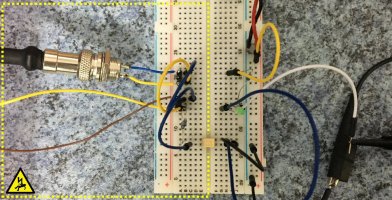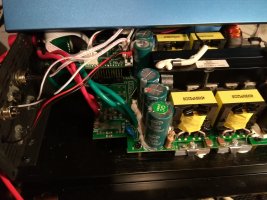I don't know if anyone is still pursuing the goal of controlling their GITL2 via the external limiter input, but I managed to pick up a used external limiter unit and have been analysing the signal and thought I would post my findings:
At first, I though it was a straightforward PWM signal, bit as I tried various different loads, it seems there is no correlation between the frequency/mark-space of the signal and the actual output power the inverter is generating.
The following table shows the signal at various output power levels:
Code:
Load Period mS Freq Hz Low mS Hi mS %
-----------------------------------------------------------
No load 6540 0.154 1120 5420 79.3
30W 640 1.562 476 164 34.4
60W 458 2.813 326 132 40.5
90W 320 3.125 234 86 36.7
120W 242 4.132 170 72 42.3
150W 448 2.232 356 92 25.8
180W 640 1.562 476 164 34.4
So, as you can see 30W and 180W produces exactly the same signal. After puzzling over that for a while, I started watching the signal as I changed the load and I think I have figured it out.
The image below shows the signal as I change the load from 50 to 100 and back to 50W. The limiter holds the line low for an extended period to demand more power and high to demand less (signal is inverted due to how I am monitoring it).

Once the correct output power level is detected by the limiter it goes back to some nominal frequency/mark.
So it looks like the limiter does not send an absolute output power request to the inverter, but instead sendsmore/less requests until the required output power
is achieved. In other words, it is some type of balanced feedback system.
Therefore, my Arduino solution is going to have to know the output power at all times in order to balance the output to the required level. So I will either need to add a CT clamp input, or use the serial Modbus interface to read the current output power level (have been translating parts of the Chinese spec @Tocan posed earlier, and it looks promising) in order to correctly mimic the signal.
Hmm, more complicated than I had hoped, but doable.
DANGER WARNING:
If anyone wants to replicate this experiment, please read below!
Before I event powered up the limiter unit I couldn't resist whipping the lid off to see how it worked (who doesn't to that

).
I was horrified by what I found. If I had connected the mains input to the terminal block, as per the label, one if the pins on the signal connector that goes to the inverter would have been 240VAC live mains!!!
Even if I assume the factory stuck the label on the wrong way around (which I think is the case since it also meant the L/N of the front sockets get swapped), that still leaves the neutral connected to one if the pins. That is just as bad, but perhaps not as lethal.
At best I could have blown up my oscilloscope and worst case electrocuted myself. This is only a low voltage signal (a few volts) to drive an LED in the opto-coupler inside the inverter. I have no idea why it is connected like this.
Anyway, I would recommend that anyone who has one of these external limiter units perform the following test:
1.Disconnect ALL wires.
2.Using a multimeter, perform a continuity test between the live/neutral connections and the pins on the limiter output connectors.
If there is continuity, then in my opinion it is not safe.
It is not for me so say what to do about it if yours is the same as mine, but I personally, would not use it or would modify it to make it safe.
Note also that the metal housing of the signal connector is not even earthed.
The image below shows my little opto-isolated breadboard setup allowing me to safely monitor the signal (I had the left half covered up whilst powered).

Sorry for such a long post but thought others may find it useful.








